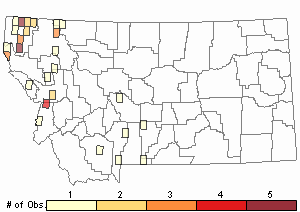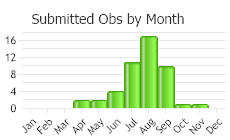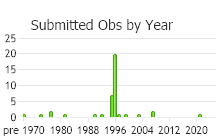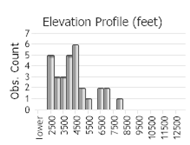View in other NatureServe Network Field Guides
NatureServe
Montana
Utah
Wyoming
Idaho
Wisconsin
British Columbia
South Carolina
Yukon
California
New York
Taiga Mat Moss - Brachythecium erythrorrhizon
Other Names:
Taiga Ragged Moss
General Description
Plants: Pleurocarpous (Vitt 1988). Growing in open to somewhat crowded mats, straw-colored, pale green (FNA 2014) to dark green (Lawton 1971). Stems prostrate, to 6 cm in length and branches to 10 mm, leafy, in X-section the stems appearing round to flattened (FNA 2014), erratically to nearly pinnately-branched; branches short and bowed (Crum and Anderson et al. 1981), leafy, round in X-section; possessing a central strand (FNA 2014); rhizoids numerous in clumps underneath the stems (Crum and Anderson et al. 1981).
Leaves: Stem leaves overlapping, upright to spreading somewhat, lance-shaped and somewhat egg-shaped, curved and pointing toward one side of the stem, widest a little above the base, moderately to strongly pleated longitudinally, cupped, 1.2-2.3 mm in length, 0.6-1.1 mm in width, widely extending down the stem for a small distance; margins flat to frequently curved back and downward much of their length, smooth or faintly toothed, moreso distally; apex narrowing to a short or long acumen; costa over half the leaf length, ending well before the tip. Branch leaves smaller, otherwise comparable to the stem leaves (FNA 2014).
Leaf Cells: Alar cells small and nearly square or slightly elongate, the walls somewhat incrassate, the alar region rather large; laminal cells long and slender; basal cells arranged in 2 or 3 tiers (FNA 2014).
Brachythecium erythrorrhizon var. erythrorrhizon: Present in Montana. Leaves curved and pointing toward one side of the stem, 1.5-2.3 mm in length (FNA 2014).
Brachythecium erythrorrhizon var. alpinum: Leaves not curved, 1.2-1.7 mm in length, strongly folded longitudinally and very cupped (FNA 2014).
Diagnostic Characteristics
B. erythrorrhizon has moderately to strong pleated and mostly conspicuously curved leaves. The similar B. albicans has leaves faintly pleated at most and only slightly falcate (FNA 2014).
Brachytheciastrum leibergii is autoicous rather than dioicous, and tends to be a somewhat deeper green, frequently maturing to golden and orange (FNA 2014).
Range Comments
North American Range
Brachythecium erythrorrhizon
Evidently extensive in the West (Crum and Anderson et al. 1981).
Variety erythrorrhizon
AK s to CA, extending east in the USA to MT s to NM (except AZ); in the Northeast found in NY, ME, ON, QC, NB and NL (FNA 2014). Known in Montana from Carbon, Carter, Cascade, Flathead, Gallatin, Glacier, Lake, Missoula, Phillips, Sweet Grass, and Ravalli Counties (Elliott 2016).
Variety alpinum
Rocky Mountains of CO and WY (FNA 2014).
Observations in Montana Natural Heritage Program Database
Number of Observations: 48
(Click on the following maps and charts to see full sized version)
Map Help and Descriptions
Relative Density

Recency



 (Observations spanning multiple months or years are excluded from time charts)
(Observations spanning multiple months or years are excluded from time charts)
Habitat
Variety erythrorrhizon: Soil, humus (Elliott 2016), rock; mountains. Elevation: 0-11,480 feet (FNA 2014).
Variety alpinum: Mountains (FNA 2014).
Reproductive Characteristics
Dioicous. Seta russet, 8-17 mm in length. Capsule tilted to level, bowed, to 2 mm in length (FNA 2014).
Stewardship Responsibility
References
- Literature Cited AboveLegend:
 View Online Publication
View Online Publication Crum, H.A. and L.E. Anderson. 1981. Mosses of Eastern North America. 2 volumes. Columbia University Press, New York. 1328 pp.
Crum, H.A. and L.E. Anderson. 1981. Mosses of Eastern North America. 2 volumes. Columbia University Press, New York. 1328 pp. Elliott, J.C. and A.K. Pipp. 2018. A Checklist of Montana Mosses (1880-2018). Updated 3 January, 2020. Montana Natural Heritage Program, Helena, Montana. 73 pp.
Elliott, J.C. and A.K. Pipp. 2018. A Checklist of Montana Mosses (1880-2018). Updated 3 January, 2020. Montana Natural Heritage Program, Helena, Montana. 73 pp. Flora of North America Editorial Committee, eds. 2014. Flora of North America North of Mexico. Volume 28. Bryophytes: Mosses, Part 2. Oxford University Press, Inc., NY. xxi + 702 pp.
Flora of North America Editorial Committee, eds. 2014. Flora of North America North of Mexico. Volume 28. Bryophytes: Mosses, Part 2. Oxford University Press, Inc., NY. xxi + 702 pp. Lawton, E. 1971. Moss Flora of the Pacific Northwest. Hattori Botanical Laboratory. Japan: Yamabuki-cho, Shinjuku-ku, Tokyo. 362 pages plus appendices.
Lawton, E. 1971. Moss Flora of the Pacific Northwest. Hattori Botanical Laboratory. Japan: Yamabuki-cho, Shinjuku-ku, Tokyo. 362 pages plus appendices. Vitt, D. J. Marsh, and R. Bovey. 1988. Mosses, Lichens & Ferns of Northwest North America. Seattle, WA: University of Washington Press. 296 p.
Vitt, D. J. Marsh, and R. Bovey. 1988. Mosses, Lichens & Ferns of Northwest North America. Seattle, WA: University of Washington Press. 296 p.
- Additional ReferencesLegend:
 View Online Publication
View Online Publication
Do you know of a citation we're missing? Elliot, J. C. 1993. Second checklist of Montana mosses. Unpublished report. U.S. Forest Service, Region 1. Missoula, MT. 45 pp.
Elliot, J. C. 1993. Second checklist of Montana mosses. Unpublished report. U.S. Forest Service, Region 1. Missoula, MT. 45 pp. Flowers, S. 1973. Mosses: Utah and the West. Brigham Young University, Provo, Utah. 567 p.
Flowers, S. 1973. Mosses: Utah and the West. Brigham Young University, Provo, Utah. 567 p. Lawton, E. 1971. Keys for the Identification of the Mosses on the Pacific Northwest. Reprinted from 'Moss Flora of the Pacific Northwest'. Published as Supplement No. 2 of the Journal of the Hattori Botanical Laboratory. Nichinan, Miyazaki, Japan. 66 pp.
Lawton, E. 1971. Keys for the Identification of the Mosses on the Pacific Northwest. Reprinted from 'Moss Flora of the Pacific Northwest'. Published as Supplement No. 2 of the Journal of the Hattori Botanical Laboratory. Nichinan, Miyazaki, Japan. 66 pp. Smith, A.J.E. 1980. The Moss Flora of Britain and Ireland. Cambridge University Press, Cambridge. 705 pp.
Smith, A.J.E. 1980. The Moss Flora of Britain and Ireland. Cambridge University Press, Cambridge. 705 pp.
- Web Search Engines for Articles on "Taiga Mat Moss"





